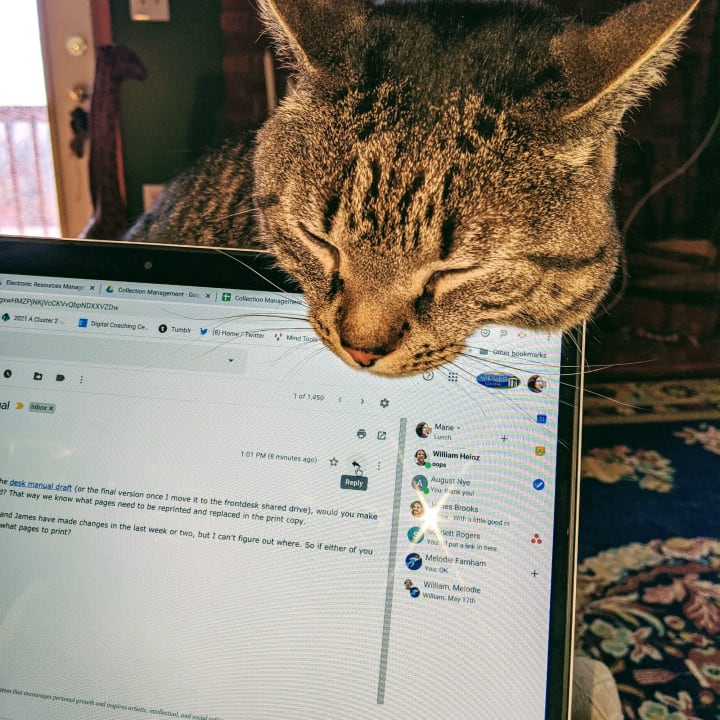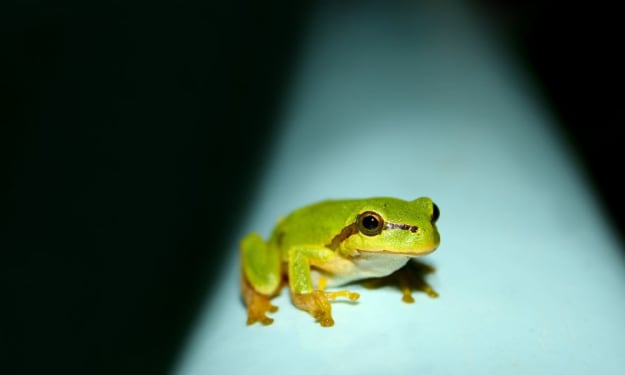
She smiled at us with her whole body, her white flag tail waving madly, a grin on that sweet doggie face. How could we resist this gorgeous animal who clearly wanted to go home with us? It was love at first sight, remarkably, for both of us.
The Search for the Perfect Companion
My partner and I had been visiting all the shelters in our area, looking for a sweet-tempered adult dog that we could both love. We came at this decision from opposite ends of the dog spectrum. When we got together, he had a Great Pyrenees mix, a placid giant named Alley, for the backstreet where she was found. My rescue was a Pekingese with a smoker's bark and separation anxiety.
Compromise, of course, was necessary. I prefer dogs I can scoop up when they run amok. Davis thinks any dog under 40 pounds isn't a Real Dog and detests "yappy dogs." A mid-sized dog, then. One that would enjoy long walks and hikes in our rural neighborhood.
We worked our way through the shelters. I wanted to take every sad-eyed puppy home from the crowded and loud conditions they lived in. I was afraid they'd all be euthanized before they were adopted. Davis was much more level-headed, turning down beagles and chihuahuas, hounds and bulldogs. No barkers. None that were too timid or aggressive.
Finally, at the no-kill shelter, we found our sweet girl. Her shelter name was "Fergie" after Sarah Ferguson, Duchess of York. We kept that name, with its Black-Eyed Peas echo. Now I can't imagine her as anything else.
If you have a chance to support a no-kill shelter, please do. Of course, all shelters need support, and "high kill" shelters may simply need more support to lower their kill rates. Every shelter needs donors, adopters, and community support to help animals.
But no-kill shelters place all possible animals, retraining those with behavioral issues and treating those with health issues whenever possible. The shelter where we found Fergie "fixed" and microchipped her. The microchip, they told us, would direct people back to the shelter so that they would know if we weren't being responsible owners. They also tattooed her belly to signify that she'd been spayed. We paid more to adopt her than we would have elsewhere, but all of these services were well worth it.
First day at home

I brought Fergie home from the shelter on one of those glowing spring days when everything feels new and fresh. I spread out a blanket in our yard and we napped together in the sunshine. I felt blessed that she trusted me so easily. But I worried that she might be too calm for my spouse, who really wanted a dog to play with.
Little did I suspect the truth.
The English Setter
As with most love-at-first-sight relationships, there were surprises once the first blush of infatuation was over.
Dog breeds have distinct personalities, but shelter dogs can have less intense traits since they are most often mixed breeds. But Fergie is absolutely pure-bred English Setter.
The American Kennel Club (AKC) describes the English Setter as "a medium-sized sporting dog of sweet temper and show-stopping good looks" with a temperament that is friendly, mellow, and merry. Again, that perfectly describes our dog...except when she's not mellow.
Neither of us had ever owned a "sporting class" dog before. Fergie was bred to be a bird dog. Here's Jerry Thoms' beautiful description of a bird dog in action:
When Jill, the 18-month-old English setter, was released in the 20-acre hayfield, the 45-pound white, orange and black dog took off like she was on fire. In just a few minutes, Jill covered most of the 20 acres so fast and with such fury that finding a bird seemed unlikely, maybe even impossible.
Then, way down in the furthest corner of the cover she slammed into a solid motionless point — something like an English setter from a classic painting or famous sculpture or a well-done photograph.
That's perfect behavior for a hunting dog, but her speed and love of running can be challenging for us. We have never been able to train her to walk on a leash properly, even though we give her two walks a day. (That's probably our fault--she is completely trainable. We just suck at the consistency it takes to train a dog to do things they really don't want to.)
Food
Like many shelter dogs, Fergie's primary motivation in the world is food. We wonder how long she was on her own in the woods before she was picked up and taken to the shelter, because some of her food habits are charming or annoying...others are just gross.
My favorite of her food quirks is that she loves to eat blackberries. When they are in season, we have a particular stop on our walk where we pick blackberries and have a snack. And I mean we pick the berries. She very delicately pulls her lips back and plucks wild blackberries directly from the cane, avoiding the thorns better than I ever can. I wish I had a picture, but I'm usually too busy eating the berries myself to capture the moment.
And daily feeding routines can be comical--or seriously annoying--depending on our mood. Here's how our mornings go:
1/2 hour before alarm: Mike-the-Cat (also a shelter adoptee) settles on my shoulder and purrs with the power of a semi-truck idling.
15 minutes before alarm: As Mike nuzzles my ear or nibbles on my chin, Fergie stomps from one end of the house to the other, nails clicking on hardwood floors as loudly as possible. When she enters the bedroom, she Scooby-Doo talks to us before her next round of stomping.
The stomping becomes more aggressive until one of us gets up to feed her. This year, she has added "Woof!" to her morning conversation. The Husband does not approve.

The afternoon routine is more focused but starts much earlier. I do not know how she can tell time so precisely, but she wakes up and begins intense staring precisely TWO HOURS before her regular feeding time. During that time, the staring escalates to stomping, and Mike-the-Cat adds his distractions to the game (above).
Finally, at 4:00, she goes into a frenzy of joyous dancing bliss when we add food to her dish. Mealtime! And then a WALK!
And NOT cute
Our least favorite food quirk is poop-eating. Coprophagia is a thing. She's very sly and stubborn about getting what she wants.
For example, we have a gate with a cat door to keep her from getting to the cat litter. She actually figured out how to wiggle her way through that little cat door, a feat that I did not think was physically possible.
We found other ways of thwarting that plan, but snacking on our walks is a lot grosser when blackberries aren't involved.
You see, we live in the country, so we don't take plastic bags to clean up after her. And no one is cleaning up after the deer, bunnies, fox, bear, and other creatures in our neighborhood, either. I spend my walks repeating, "NO EATING!" every time a sniff looks like it might lead to a snack. It's exhausting.
Hunting for Food
When you combine her passion for food with her breed, my sweet-tempered Fergie can be a serious predator. She does point at birds and other animals, but her retrieval is much less gentle.
When you combine her passion for food with her breed, my sweet-tempered Fergie can be a serious predator. She does point at birds and other animals, but her retrieval is much less gentle.
I remember one idyllic rural morning, looking out the window with Davis, my back leaned against him and his arm around me, sipping coffee and feeling content. A pair of the neighbor's free-range chickens were pecking in the driveway. I commented on how fluffy the pure white chicken was and how glad I was to see them out there.
Moments like that never last. Later that day, Fergie slipped away from us as we were loading her into our truck to go out. She headed straight into the woods behind the driveway and found those same two chickens. They were both dead before we could even catch up with her.
In our early years with her--before the chicken incident--Fergie would run in the pastures near our home with other neighborhood dogs. Sometimes she would bring home "presents" of small carcasses or body parts. Probably the most notable was a whole dear head. I am very glad that my beloved was willing to clean these up for us.
But the live retrievals might have been more traumatic for us.
One particularly memorable evening, I came home from work to Fergie carrying a dark animal about the size of a guinea pig in her mouth. After much coaxing ("Drop it!" has never quite sunk in), she let us take it from her. It was still alive, making noises like a squeaky toy. We took it to a regional wildlife rehab center. Once they cleaned it up, they identified it as a baby mink, probably orphaned, since it was covered in ticks and not very healthy even before Fergie found it. I'm happy to say that it survived to be rehomed near a creek.
Another spring day, she came dragging home a fawn. I didn't know that baby deer could scream, but yeah, they do. It seemed unharmed once we separated them, but it did hang around long enough to have its picture taken.

When she brought a baby deer home again the next year, we stopped letting her run free. That was hard on her, but the neighbor's chickens really appreciated it (except for the occasional leash-slip).
Aging Happens
Last year, Fergie had an episode that we think was a stroke. She was out in her favorite place on our front deck, overlooking the neighborhood, but suddenly started shaking and she looked terrified. When she came in, she collapsed on her bed and went to sleep.
A bit later, she started walking in circles in the house, always counterclockwise, unable to turn around when she got stuck between pieces of furniture or in corners and falling down randomly. We even had to coax her to eat--which had never happened in the 13 years she's been with us.
We waited outside the emergency vet's for hours. With COVID, no one was going inside with their pets in routine situations, but they let me go with her. They monitored her heart, did blood work and x-rays. We opted not to have an MRI to see if it was a stroke, for sure.
The x-ray showed a more troubling issue--a mass on her spleen. That was probably not the cause of her behavior change (nor was the rock-like object in her stomach), but either of those issues would likely be fatal. When I searched for information about splenic masses, everything I found said that she would have only a few months to live, even if we had the mass removed. At her age, it seemed cruel to put her through major surgery.
We decided to take her home and give her as much love and joy as we could, resigning ourselves to the fact that we'd probably have to euthanize her soon. We agreed that we wouldn't do anything as long as she seemed to be enjoying life--eating, smiling at us, going outside, and hanging out on the deck.
Today
That was more than six months ago. She still has problems keeping her back legs under her and she's not quite as sharp as she used to be. But she seems happy, is still delighted for every meal and every walk.
In fact, yesterday, she sneaked past me at the door and took off running through the neighborhood, only a little more slowly than she would have a year ago. I don't think I have to worry about her taking out a chicken.
But every morning, when I hear her stomping around the house, I smile and am glad that we've been given another day together.

About the Creator
Marie Jones
I'm a writer, librarian, coach, and consultant.
Check out my newly released book: The Messy Planner : The planning system that embraces inconsistency and randomness!
Enjoyed the story? Support the Creator.
Subscribe for free to receive all their stories in your feed. You could also pledge your support or give them a one-off tip, letting them know you appreciate their work.






Comments
There are no comments for this story
Be the first to respond and start the conversation.